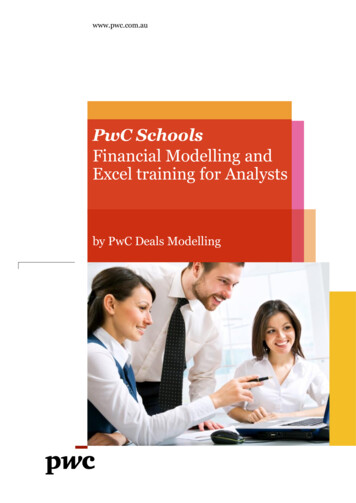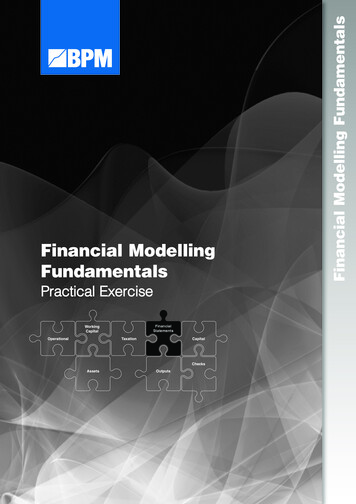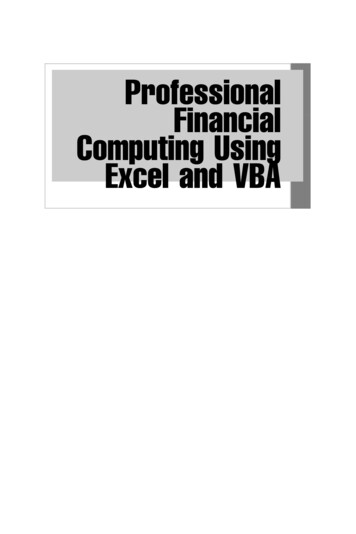
Transcription
www.pwc.com.auPwC SchoolsFinancial Modelling andExcel training for Analystsby PwC Deals Modelling
Are you unsurehow to maximise yourmodelling andanalyticalcapabilities?Modelling and analytics are both ways to deriveinsight to add value to your organisation, and areessential to support today’s fast-paced decisionmaking needs. However, many businesses lack theresources or expertise to develop their analysts tofully unlock their potential.PwC’s Schools program for analysts is drawn from thefoundation of our experience, lessons learned andinsights from across our global network. It is designedto: Embed consistent skills and approaches Teach best practices Leverage a deep base of analyticalexperienceWould you liketo developyour talent?What does PwC Schools training program foranalysts involve?Our three layered approach to training supportsanalysts to build their skills base as they progress intheir career.The program has been designed in a ‘modular’ format,so individual components can be delivered together orstand alone and can be tailored to your individualneeds.Our programme is mostly industry agnostic, andfocuses on the core problem solving skills that can bedeployed with agility everyday in your organisation.However, we often tailor it for the specific needs ofclients and their industries.Where should you start?Our courses provide the technical foundations to provide your analysts to developtheir current skills, no matter what stage they are in their career journey.Course1.11.21.32Introductionto modellingProfessionalmodel buildExpertfinancialmodel buildDescriptionDurationAnalystsexperience levelA comprehensive excel overview including use ofshortcut keys, customising Excel setup and PwC’s toptips. It includes an introduction to best practicemethodology for building robust, easy to use models.2 daysBasicAn advanced course providing a comprehensivereview of all phases of PwC’s best practice modellingmethodology, including advanced use of certain Excelfunctions including adding “navigation” and“error check” maps to models.2 daysModerateThe construction of more complex and specific modelsthat incorporate integrated ‘3-way’ financial statements,debt schedules, ratio and covenant modelling,sensitivity analysis and using data tables. Analysts willalso be given an introduction to using VBA.2–3 daysAdvancedPwC Education - Excel training
PwC’s analyststrainingapproachGraphing &datavisualisationMarketinsights fromindustryspecialistsIntro toSAS sentialmodelbuildFinancialstatement sIntro toModellingDataquality andenhancement Intro togeospatialanalysisA three layeredapproachVBA turingandmodellingBusinesscase &projectmodellingCareercurriculumIntro toDatabasesIntro toprogrammingfor businessProjectfinancemodellingM&A BusinessskillsPersonaleffectivenessThink onyour feetPresentationsBusinessskillsmodulesTechnical ltingskillsNegotiationNetworking &relationshipsSixSigmaAdaptable toyour needsTalentmanagementPublicspeakingStart at the beginning.Our approach providesanalysts with the coretechnical skills neededbefore developingbusiness and leadershipskills.Work alnetworkMentoringWorkingwith foreignculturesExcel forExecutivesPersonalvaluepropositionand planRiskmanagement3
Financial Modelling and Excel training:course content detailsCurrent courses availableCourseDescriptionSummary of key content1.1Builds on excel fundamentalsand adds in some of theelements of Advanced Excel,but also introduces some coremodelling approach Most of the elements of the Advanced Excel course Does not include range names, arrays, offset, sumproduct,excel set-up, pivot tables Practical introduction to PwC’s 15 best practice top tips Introduction of the Axis of Spreadsheet Evil Introduction to PwC’s Model Build methodology: Scope, Specify,Design, Build, Test, HandoverBuilding robust and flexiblemodels in Excel for modellersalready comfortable with usinga lot of Excel’s functionality Review, and some extension of, features from the Advanced Excelcourse All phases of PwC’s Best Practice Model Build Methodology includingScope Specify Design Build Test Handover Thorough review of PwC’s 15 best practice top tips The “Axis of Spreadsheet Evil” – which functions to avoid, how and why Adding navigation features to models, including Error check “maps” Building dynamic charts incorporating use of drop down menus andtick boxes Introduction to customisation of charts and data visualisation concepts Model review and audit: Using Excel’s inbuilt functionality and beyondTechniques for building morecomplex but efficient andusable financial models Review and extension of features from the Essential Model Build courseincluding all phases of PwC’s Model Build methodologyScope Specify Design Build Test Handover Thorough review of PwC’s 15 best practice top tips Specific techniques for integrated “3-way” financial models Scenario modelling Data tables Ratio and covenant modelling Introduction to VBA to provide additional levels of control,customisation, navigation, use and analysisFor modellers who arecomfortable in build modelsand want to be empowered tobuild “Project Finance” modelsby covering comprehensiveProject Finance logic andfoundations Introductionto modelling1.2Professionalmodel build1.3Expertfinancialmodel build1.3ProjectFinanceModelling4PwC Education - Excel trainingIntroduction to Theory of Project FinanceForms of LendingComponents of a Project Finance modelThe A-Z of Debt Sizing & SculptingDSRA and DSCRCash WaterfallCommon SolvesLeavers you can pull
Modules for bespoke training experiencesWe have developed a wide range of courses to meet our client’s bespoke training needs and draw on the courses outlined on previouspages, and the additional modules set out below.All of our courses contain a case study, most of which are tailored to the client’s industry and Graphing& dataVisualisationVBA formodellersModelreviewDescriptionSummary of key contentEntry level course to improveunderstanding of Excel as amodelling and analytical tool Designed to make people who arealready using Excel far moreefficient and effective Comprehensive overview of Shortcut keys, including functionality ofAlt and Ctrl and advanced features of some of the function keys “Moving fast” in Excel Customising Excel default set-ups for more efficient world Custom styles and number formatting Conditional formatting Logic functions and other advanced functions Date functions Advanced use of Range Names and associated risks Use of “Masks” and flags Efficient formula creation Advanced use of F5 functionality Introduction to Pivot tablesComplements a practical approachto graphing with a good-practiceapproach to data visualisation toadd a valuable presentational layerto communicate results effectively Quick charts Dynamic charts› Use of drop down menus› Dynamic data ranges Customising charts Determining the most appropriate and effective chart to use Dual axis charts Dashboard developmentUsing VBA to expand Excel’sfunctionality and increasemodel power Understanding VBA, including: Modules vs. routines vs. functions;Variable types, Option Explicit Risks of VBA Building macros from scratch: layout and naming conventions Use of VBA to add additional levels of performance andcustomisation: Disclaimers; Security; Printing; Navigation Editing code Methods to avoid circular references eg solvers Use of the function keys for more efficient testing and review of VBA Debugging techniques and use of the immediate window Building and using formsHow to use Excel’s specific in-builtreview tools effectively, plus how touse other Excel functionality toefficiently and effectivelytest models What do we mean by “review”› The extent and limitations of a review› Attributes of a good reviewer Best practice review techniques and issues to be aware of Quick testing through use of F2 and formula view Tracing precedents and dependents using Excels inbuilt tools Advanced use of F5 Specific tricks and techniques List of specific common errors to check for Discussion of some of bespoke tools availableUnderstanding how Excel “thinks”Shortcut keysHow to enter simple formulasSimple formatting in ExcelIntroduction to Range NamesIntroduction to graphs5
Why PwC?We take a business led approach to training as we believe analytics shouldtell an understandable story that both provides and embeds useable insightin an organisation to really drive value.This program has been delivered and refined over manyyears to ensure it is relevant and cutting edge.Our trainers are real-world practitioners with 15 years offinancial modelling experience and are actively deliveringcomplex solutions across a range of industries.Critical thinking and analysis is interwoven into each moduleto ensure practical application into everyday situations.Our program can be tailored to match your enterprise andindustry to maximise relevance and enable adoption of thelearning’s immediately.The program has been designed in modular format,so that individual components can be either deliveredtogether or stand alone.Program delivery methods, styles and locations are flexibleto match your needs.6PwC Education - Excel training
ContactsContact us to discuss your needs and help us design a curriculumto add analytical power to your organisation.Ian Bennett 61 (2) 8266 2927ian.bennett@pwc.comFarouk Dahbourah 61 (2) 8266 2315farouk.dahbourah@pwc.comThuthuka Manasa 61 (7) 3257 5400thuthuka.manasa@pwc.com7
2018 PricewaterhouseCoopers. All rights reserved.PwC refers to the Australia member firm, and may sometimes refer to the PwC network. Each member firm is a separate legal entity. Please see www.pwc.com/structure for further details.This content is for general information purposes only, and should not be used as a substitute for consultation with professional advisors.Liability limited by a scheme approved under Professional Standards Legislation.At PwC Australia our purpose is to build trust in society and solve important problems. We’re a network of firms in 158 countries with more than 236,000 people who are committed to deliveringquality in assurance, advisory and tax services. Find out more and tell us what matters to you by visiting us at www.pwc.com.au.WL 127062621
Excel for Executives Personal value proposition and plan Working with foreign cultures Mentoring Media skills Risk management Business skills modules Leadership modules Start at the beginning. Our approach provides analysts with the core technical skills needed before deve











